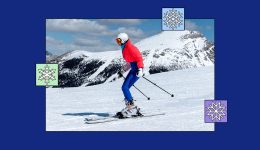
5 Winter Workouts To Stay Active in the Snow
That combo is something Doug Guthrie, USAT-certified coach and founder of GU3 Training, knows all about. As an accomplished distance athlete, Guthrie utilizes the offseason to relish in reduced training demand.
“I look forward to winter training for a couple of reasons,” he says. “I’m able to train without the pressure of a race right around the corner. I can exercise for the enjoyment of what it brings to my mind and body and not the ‘work’ of having to hit certain training metrics in the middle of a race build.”
For the athletes he trains, the offseason isn’t a time to check out from movement altogether, but rather an opportunity to build strength in other areas.
“[We’re] able to do some different things that don’t normally appear on a race-build calendar,” Guthrie says. “These would include cross-training and working on areas of improvement from the last season.” Outdoor winter workouts and sports can check those boxes, too.
Of course, there are plenty of indoor exercise opportunities. However, there are some real benefits to getting out in that snow. But what do you do out there? Enter: fun winter workouts. Staying fit in the colder months is all about finding an activity that excites you.
Why winter workouts are so good for you
Of course, exercise is essential year-round1. As a runner, you could take to the treadmill. Cyclists could join a spin class. But mixing it up can improve your physical well-being in ways that are worth exploring.
“When you perform new exercises that your body is not used to, it’s called muscle confusion,” explains Christynne Helfrich, PT, DPT, OCS, a physical therapist at Hinge Health. “This is important in training your body to adapt to different stresses and increase your strength. So when your body may be used to running on sidewalks during the summer months, switching it up [in the snow] come winter can be really helpful.”
Besides getting in your weekly quota of physical activity, here are just a few of the benefits of winter workouts:
1. Improved mental health
“Winter activities can be great for beating the cold-weather blues,” says Sydnee Mostek, RDN, registered dietitian and exercise physiologist at Rooted Wellness Academy.
When we connect with nature, there is a physical and mental reaction. Not only does this phenomenon occur in the summer months, but also in winter. Multiple studies2 have shown3 the benefits of outdoor exposure and show that even a brief, 15-minute walk in a forest decreases heart rate and cortisol levels.
City dweller? Not to worry. The same results were replicated in an urban forest park setting. A quick jaunt to your wooded city recreation area may be just the thing to relieve your stress.
2. Enhanced heart benefits
We know exercise is important for heart health, but it seems there is something about the cold that enhances the benefits. One review4 found that exercising in the cold increases anti-oxidative capacity (your body’s way of fighting damage), immune response, and increased secretion of exerkines5 (the beneficial molecules produced in response to exercise).
3. Better body appreciation
Yep: Turns out nature can even make us more content with our bodies. A stroll outside can elevate your state of body appreciation6. A meta-analysis7 found that body appreciation has a trickle-down effect of better eating habits, improved body image, and enhanced mood.
Winter sports that double as workouts
When it comes to cold-weather workouts, you may be envisioning winter Olympians zooming down high-altitude cliffs, but taking up a winter sport doesn’t mean you have to go barreling down a mountain.
Sure, downhill skiing is a thrilling way to get some exercise, but it’s far from your only option. These outdoor sports will all get your heart rate up and make winter one of your favorite seasons:
- Ice skating: Whether you’ve got moves like Michelle Kwan or you’re a beginner, gliding on the ice on skates can give you an edge. Ice skating pro, Moira North, previously told Well+Good, “Skating improves balance and coordination, and you learn to make micro movements to constantly adjust to the glide and friction. Adding in speed and angular momentum forces your body to become stronger than just going to the gym and repeating the same movements over and over.”
- Snowshoeing: If you can walk, you can snowshoe. An activity essential for winter transportation for thousands of years, snowshoeing allows you to walk through the deepest of snow. And if you want to maintain the endurance that you’ve built up over the summer season, regular heart-pumping snowshoeing sessions are a terrific off-season option as it has similar fitness gains8 to running.
- Cross-country skiing: While you can strap on cross-country skis and blaze a trail in just about any open space, many recreational areas have groomed trails just for this purpose. It’s an outstanding way to build endurance and leg strength in a fresh blanket of snow. “We use every muscle to turn the skis, with emphasis on abdominals, glutes, quads, and hamstrings,” Guthrie adds.
- Fat-tire biking: Is it a little too icy to ride your regular bike? Fat-tire biking allows for cycling on unstable terrain, like new-fallen powder. The hefty tires are much wider than your average bike and have plenty of traction to keep you on top of the snow.
- Sledding: This beloved winter activity isn’t just for the kids. Playing doesn’t have to stop when you age. Grab your sled and embrace the wind rushing through your hat-covered hair. Trekking it back uphill is where you’ll get your heart pumping and glute work. If you’ve ever hauled a child up a hill in a sled, you’ll have felt the burn.
“In addition to great cardio, snow sports also are strength workouts,” Guthrie says. Snow adds a degree of resistance9 to even a simple walk. Your muscle groups will be actively engaged during any of these frosty activities.
Where to start with winter workouts
Not sure where to begin? “Just try a few things out!” Mostek suggests. “Slopes have equipment you can rent and lessons to build your confidence. Look for a skating rink nearby and swallow your pride for an hour or two.”
Nowhere near a mountain? Cross-country skiing or snowshoeing are impressive workouts. Check to see what your community has to offer—it’s probably more than you think. Furthermore, you don’t have to try a new sport. You can walk or run outside with a good pair of grippy shoes.
To make winter activities more enjoyable, bundle up. “Stay safe, and dress in warm layers, being sure to protect your face in high-speed sports or if it’s really cold,” advises Mostek. And don’t go it alone. “Finding a friend to get outside with you will make it more fun and could have an extra mood-boosting effect,” she adds.
The gym will always be there and can be a useful tool for your wellness. But for those looking to take advantage of all the seasons, winter sports are where it’s at.
Mostek sums it up perfectly: “By engaging in a winter sport, you’ll not only maintain your aerobic fitness, but you’ll work muscles in different ways than some of your warm-weather sports, resulting in improved strength when the ice and snow are gone. That means reduced risk of injury and improved performance.”
Well+Good articles reference scientific, reliable, recent, robust studies to back up the information we share. You can trust us along your wellness journey.
- Piercy, Katrina L et al. “The Physical Activity Guidelines for Americans.” JAMA vol. 320,19 (2018): 2020-2028. doi:10.1001/jama.2018.14854
- Peterfalvi, Agnes et al. “Forest Bathing Always Makes Sense: Blood Pressure-Lowering and Immune System-Balancing Effects in Late Spring and Winter in Central Europe.” International journal of environmental research and public health vol. 18,4 2067. 20 Feb. 2021, doi:10.3390/ijerph18042067
- Song, Chorong et al. “Effects of Walking in a Forest on Young Women.” International journal of environmental research and public health vol. 16,2 229. 15 Jan. 2019, doi:10.3390/ijerph16020229
- Feng, Zihang et al. “Exercise in cold: Friend than foe to cardiovascular health.” Life sciences vol. 328 (2023): 121923. doi:10.1016/j.lfs.2023.121923
- Magliulo, Laura et al. “The wonder exerkines-novel insights: a critical state-of-the-art review.” Molecular and cellular biochemistry vol. 477,1 (2022): 105-113. doi:10.1007/s11010-021-04264-5
- Czepczor-Bernat, Kamila et al. “The Impact of a Woodland Walk on Body Image: A Field Experiment and an Assessment of Dispositional and Environmental Determinants.” International journal of environmental research and public health vol. 19,21 14548. 5 Nov. 2022, doi:10.3390/ijerph192114548
- Linardon, Jake et al. “Body appreciation and its psychological correlates: A systematic review and meta-analysis.” Body image vol. 42 (2022): 287-296. doi:10.1016/j.bodyim.2022.07.003
- Connolly, D A J et al. “Changes in selected fitness parameters following six weeks of snowshoe training.” The Journal of sports medicine and physical fitness vol. 42,1 (2002): 14-8.
- Richmond, Paul W et al. “Terrain coefficients for predicting energy costs of walking over snow.” Applied ergonomics vol. 74 (2019): 48-54. doi:10.1016/j.apergo.2018.08.017





